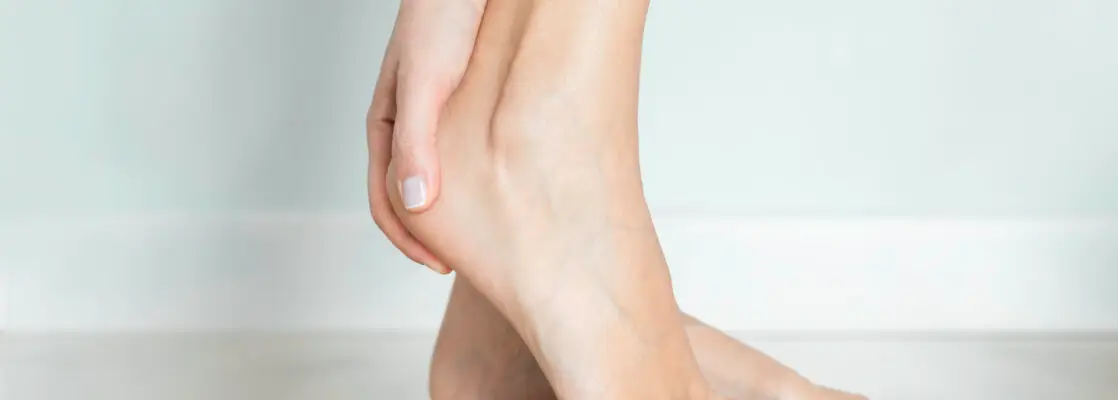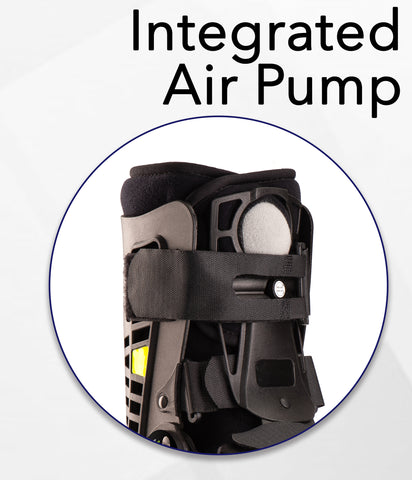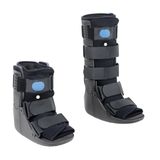
Foot & Ankle Brace
Ergoactive Injury Booth - Off Load Pressure
Combined with its dynamic, three-module shock absorption system (heel-flat-toe), the SHOEBAUM SHORT also offers a lateral sliding, gait-mimicking insole. Together, with an adjustable ROM hinge, pneumatic inner cushion liner, and compact design, the SHOEBAUM SHORT is the most comfortable and advanced injury boot/air CAM walker available.
HIGHLIGHTS





SPECIFICATIONS
USER SHOE SIZE RANGE: Women: 7.5 - 11.5 Men: 8 - 12.5
UNIT WEIGHT: 2.90 LBS
OVERALL HEIGHT: 12"
OVERALL WIDTH: 5.50"
OVERALL DEPTH: 12"
FLOOR TO INSOLE HEIGHT: 3"
RANGE OF MOTION (ROM): WOMEN: 90º - 100º MEN: 105º - 115º
*MATERIALS ARE LATEX FREE
WARRANTY
Your SHOEBAUM SHORT boot is warranted against defects in material and/or workmanship for one (1) year. This warranty does not extend to accessories and non-durable components such as soles, insoles, soft goods, or straps which are subject to normal wear and replacement. Non-durable or consumable components are warranted against manufacturer defects for 30 days.
RETURN POLICY
This product is non-returnable. It is considered a single-use patient item. Refer to Ergoactives’ Return Policy for further details.
INTERNATIONAL SHIPPING
CUSTOMS
You, the customer, are responsible for all taxes and duties (including VAT) imposed by your country of residence.
Ergoactives is not responsible for any packages held by international customs agencies and it is not the responsibility of Ergoactives to make the customer aware of these agencies and their actions. Please check with your country's customs office to determine their procedures and any potential charges.
Your package may arrive at your local post office or delivery center and be held until pickup and payment is taken care of.
If you neglect to pick up your package and it is returned to us, we will not refund the charge for original shipping.
Should Ergoactives mistakenly be invoiced directly for any duties or fees from the shipping company after delivery, we will email an invoice for the balance due. This will need to paid immediately.
As with domestic shipping, if a package can't be delivered due to an error entering your shipping address, Ergoactives is not responsible for any additional fees that may incur in order to reroute or reship the package.
TRACKING
If you have a USPS package marked as delivered but haven't received it, please contact your local mail facility.
You will have to pay taxes and duties in your own country if applicable. This is something we have no control over it and by purchasing an Ergoactives product, you acknowledge that you are aware of this and accept it as your financial responsibility.


Table of Contents
Foot & Ankle Brace
Foot and ankle braces are orthopedic devices designed to provide support, stability, or protection to the foot and ankle. They are commonly used in cases of injury, chronic conditions, or after surgeries to aid in healing, prevent further injury, or manage pain and discomfort.
Types of Foot and Ankle Braces:
Ankle Stabilizers:
- Purpose: Often used for sprains, strains, or minor ankle injuries.
- Design: Typically have straps or laces that wrap around the ankle to provide compression and stability.
- Common Uses: Sports-related injuries, post-surgery recovery, or chronic ankle instability.
Lace-Up Braces:
- Purpose: Provide a higher level of support than soft braces.
- Design: Made of strong fabric with laces that tighten around the ankle, mimicking the feel of tape wrapping but offering more reusability.
- Common Uses: Ankle sprains, ligament injuries, or for athletes needing extra support during activity.
Ankle
Sleeves/Compression Socks:
- Purpose: Provide mild support and compression to improve blood flow and reduce swelling.
- Design: Elastic, lightweight material that fits snugly around the ankle.
- Common Uses: Mild swelling, soreness, or mild arthritis.
Walking Boots (CAM Boots):
- Purpose: Protect and immobilize the foot and ankle after a serious injury or surgery.
- Design: Hard, rigid outer shell with adjustable straps and a rocker sole to aid in walking.
- Common Uses: Post-surgical recovery, fractures, or severe sprains.
AFO (Ankle-Foot Orthosis):
- Purpose: Stabilizes the foot and ankle, often used for conditions that affect gait or muscle control.
- Design: A rigid or semi-rigid brace that fits into a shoe and extends upward along the leg.
- Common Uses: Conditions like drop foot, cerebral palsy, multiple sclerosis, or stroke recovery.
Night Splints:
- Purpose: Maintain foot and ankle positioning while sleeping, usually to treat plantar fasciitis or Achilles tendonitis.
- Design: Holds the foot in a dorsiflexed position to stretch the calf muscles and plantar fascia.
- Common Uses: Plantar fasciitis, Achilles tendonitis, or other conditions requiring a sustained stretch.
Common Uses and Benefits:
- Injury Recovery: After ankle sprains, fractures, or ligament tears, braces immobilize the area, aiding in faster healing.
- Chronic Conditions: People with chronic ankle instability or degenerative conditions like arthritis can use braces for everyday support and pain relief.
- Sports and Physical Activities: Athletes may wear braces during high-risk activities to prevent injuries.
- Post-Surgical Use: Braces help protect the healing area after surgeries like tendon repairs, ankle fusions, or fracture fixations.
Important Considerations:
- Proper Fit: Ill-fitting braces can lead to discomfort or worsen the injury, so professional fitting is often recommended.
- Material: Braces can be made from various materials like neoprene (for compression), plastic (for rigid support), or fabric.
- Level of Support: Depending on the severity of the injury or condition, different levels of rigidity and support may be necessary.
These devices are typically prescribed or recommended by healthcare professionals such as orthopedic doctors, podiatrists, or physical therapists, depending on the injury or condition.


